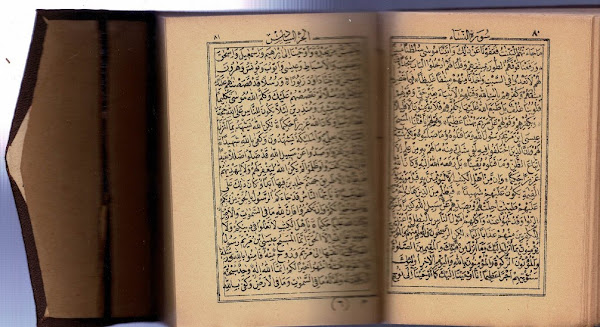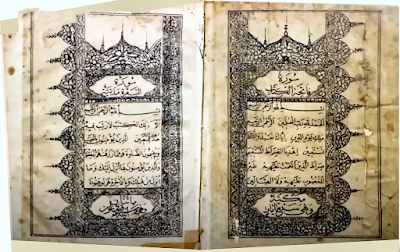The Cairo edition was published in 1924 by the printing press of Bulaq... This edition is also called the “Royal edition” (al-malikiyya or al-amīriyya)Yes, it might have left the printing press in 1342/1924, but the press of the Survey of Egypt, which lies not in al-Qāhira, not in the City of Cairo, not even in the Cairo Governorate, but on the left side of the Nile: in Giza. yes, it was published by the Goverment Printing Press in Bulāq, the Amīriyya, but in 1343/1925: type set in Bulāq, printed in Giza, bound, stamped and published in Bulāq. طبعة الحكومية المصرّية
-- . --
١٣٤٣ هجرّية
سـنة
As indicated in the bibliography, it is called "Muṣḥaf al-misāḥa wal amīriyya" after the institution that printed it (al-misāḥa = l'office national de l'information géographique = Egyptian General Survey Authority = Grundbuchamt = الهيئة المصرية العامة للمساحة) and the institution that published it (al-amīriyya). After the stamp, it is called "Egyptian Government Edition" or "der amtliche ägyptische Koran" (G.Bergsträßer), or "the 12 liner/مصحف 12 سطر" or "the 1925 King Fuʾād Edition" because there are slightly different editions in 1926,1927,1929 and an edition with almost 1000 changes (mostly just different pause signs) from 1952 ‒ all are called "Muṣḥaf al-Amīriyya", the first (al-Muṣḥaf al-misāḥa wa'l amīriyya) was made by al-Ḥusainī al-Ḥaddād al-Mālikī (d. 22.1. 1939) and the 1952 one by ʿAlī Muḥammad aḍ-Ḍabbāʿ(1304/1886-1380/1960) ‒ only the large editions (27 x 20 cm) were printed by al-misāḥa in Giza (already in 1925 there was a smaller offset printing press in Bulāq ‒ the one in Giza could print large maps). And while the early editions have nothing to do with al-Azhar, in 1952 ʿulemāʾ were involved. BTW, 1952, but before the revolution. 12 line is special, most others in Egypt (Muṣṭafā Naẓīf, aš-Šamarli/Muḥammad Saʿd Ibrāhīm al-Ḥaddād (1919-2011), Haǧǧ Ḥāfiẓ, ʿUṯmān Ḫalīfa QayišZāde an-Nūrī al-Burdurī d. 1894,ʿUṯmān Ṭaha) have 15 lines on a text page, the South African edition on 848 pages has 13 lines; just Pakistan where everything from 9 to 18 lines is common (even 6liner and 21liner exist), produces copies with 12 lines of Arabic text (both with and without interlinear translations).
This edition is also called the “Royal edition” (al-malikiyya or al-amīriyya)This is grammatically impossible, would have to be al-muṣḥaf al-malikī or al-amīrī. In fact the first name is not used for the KFE and the second is short for al-muṣḥaf al-maṭbaʿa al-amīriyya: the Govenment Press Edition. So, here are some of Chahdi's statements ‒ and the facts: first prints in Iran en 1831-1833 ‒ really 1829 in Tehran, '30 in Shiraz, '31 in Tebriz and in Tehran ‒ first type than lithography. en Inde (en 1852) ‒ really in 1829 as Mūẓiḥ al-Qurʾān (with an Urdu translation) and many from than on En Égypte même, on imprime le Coran en 1833 ‒ there exists no trace of this print : it never existed, not even a complete ǧuz L’édition du Caire [1924] est par conséquent la première édition publiée dans le monde arabe ‒ first Cairo edition was 1299/1881/2, many for the next forty years in al-Azhar Library; to my knowledge Faz/Fès where a muṣḥaf was produced in 1879 lies in the Arab world The first complete Qurʾān printed in Cairo is the Bulaq 1299/1881/2 print ‒ both in one volume and in 10 leatherbound parts. It is well known both from the Enyclopedia of the Quran and from Kein Standard: It has 13 lines per page, 603 pages in the one-volume-edition. In 1308/1890 the most important of all Cairo editions was published: "al-Muhallalātī": In 1885 an other important Cairo edition saw the light of day ‒ this one as well with "ar-rasm al-ʿuṯmānī": Let's mention more early "Cairo Editions":
All written by they same calligrapher who wrote the tremendously important 1308/1890 edition, ʿAbd al-Ḫālliq Ḥaqqī Ibn al-Ḫawaǧa, by the editor Šaiḫ Aḥmad bin ʿAlī al-Melīǧī al-Kutbī, who had a press near al-Azhar until 1919. From a copy held in a Catholic Theological Seminar in Frankurt/Main, printed 1315/1898 on 468 pages with 17 lines:
Innahu li-Qurʾān karīm fī kitāb maknūn lā yamassahu illā al-muṭahhirūn tanzīl min ...
Miṣr : al-Maṭbaʻah al-ʻĀmirīyah, 1318 [1900]
364 pp. 19 lines ; 20 cm.
all from before "the first print in the Arab world": « le manuscrit coranique intégralement écrit de la main du savant ... al-Muhallalātī » ‒ was a book printed in 1890 in al-Qāhira (see above and below) La commission mandatée par le roi Fouad est composée d’éminents savants ‒ there was no commission, they never met, they dit not discuss the text of the edition The chief reader قارئ of Egypt Muḥammad ʿAlī al-Ḥusainī al-Ḥaddād was the only Islamic scholar in the "commission"; the other three are from the Minstry of Education or the Pedagogical College next door: Hanafî Nâsif ‒ really Ḥifnī Bey Nāṣif (on his visting card: Nassef) d.1919 ʿAnānī ‒ Muṣṭafā (al-)ʿInānī (d.1362/1943) Aḥmad al-Askandarānī ‒ Aḥmad ibn ʿAlī ibn ʿUmar al-Iskandarī (1292‒1357/1875‒1938) ‒ Ḥifnī Bey Nāṣif died before any work on the edition started. I assume it was mainly his idea; the date given for the signatures is just before his death thus honouring the initiator of the edition. among the countries that have editions of their own Pakistan is mentioned, ‒ but not India, although there were important edition before and after 1947 (in Calcutta, Hooghli, Kanpure, Lucknow, Bombay, Delhi ...) Mais seule l’édition saoudienne de Médine fait vraiment concurrence à celle du Caire ‒ I'd say the opposite: first the KFE was hardly bought by Arabs, but the edition that I call "Uṯmān Ṭaha 1 / UT1" made in Medina is the one that enshrines the text of the KFE albeit the one of the 1952 edition with minor differences le ductus consonantique correspond , schématiquement , au squelette orthographique ‒ orthographique skeleton is fine, but as the Arabic script has letters (not vowels and consonants) the first expression makes no sense La commission pour l’édition du Caire se fonde sur le système de lecture de Hafs Ibn Sulaymân, ou plus précisément sur le manuscrit coranique intégralement écrit de la main du savant égyptien Radwân b. Muhammad al-Muhallalātī ‒ Abū ʿĪd Riḍwān ibn Muḥammad ibn Sulaimān al-Muḫallalātī ( ١٢٥٠-١٣١١/1834-1893) was the editor of the important edition, but the scribe was ʿAbdelḫāliq al-Ḥaqqī Ibn al-Ḫoǧa/Ibn al-Ḫawaǧa; al-Muḫallalātī's edition is important, he broke with the Ottoman orthography, instead followed in some respects the Indian system ‒ and is closer to ad-Dānī's rasm BUT al-Ḥusainī al-Ḥaddād did not follow his orthography, but more the Moroccon (Andalusian, Western) orthography ‒ and is closer to Abu Sulaimān Ibn Naǧāḥ's rasm. And there is something that could be misunderstood: on retrouve [dans les codices anciens] notamment des variantes de lecture extra-canoniques, antérieures à la période de standardisation du corpus coranique. ‒ Marijn van Putten and others have shown that ALL manuscripts follow the ʿUṯmānic rasm (diacritica and voweling non conforming to any of the canonical readings do not amount to differences in the rasm) with the exception of the erased text of the Sanaʾa Palimpsest. If it were « antérieures à la période de standardisation» des qira'āt, riwayāt et ṭuruq, it would have been clearer. ‒ ‒ ‒ ‒ ‒ ‒













































































